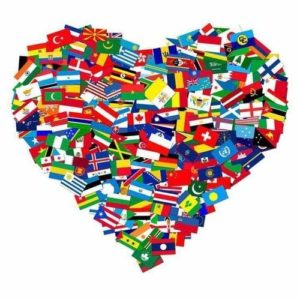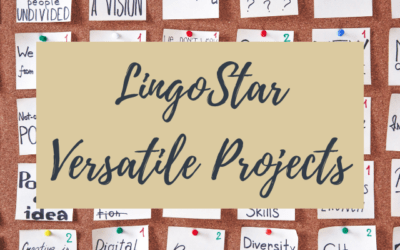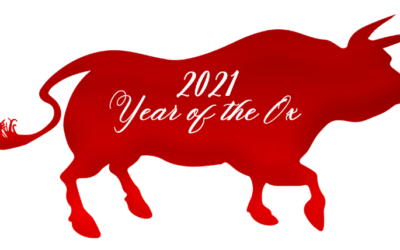Read our Translation Blog
Get the latest fun and facts from the language industry with our blog!
Need advice on website translation and localization?
Browse our ONLINE SHOP for ebooks on how to translate a website!
LingoStar’s Blog 
Welcome to LingoStar’s blog! On this page, you can find a lot of interesting and useful information about the translation industry. Explore topics on website translation and localization and how successful localization can influence your business to help your company grow and go global.
Language Blog Topics
On this blog, you can also learn about professional translators and interpreters, multilingual search engine optimization (SEO), the importance of socializing and networking and translators’ professional ethics. Quite often we write posts about the languages of the world, other cultures, and their traditions. Not only do translators convert texts from a source language to a target language, but they also help people communicate with each other, help establish international contacts, and are often prominent figures in the social, economic, and political life. Lastly, of course, we want you to have fun, so on our blog, you can find many posts that will entertain you and, hopefully, make you smile!
We hope you enjoy our blog and discover a lot of interesting things!
Are women of colour in France leading the fight against racism?
The problems women of colour face in France… France is a country rich in cultural diversity, partly shaped by its immigration. In this article, we shine the spotlight on women of colour in France, the problems they face and their struggle. It will allow you to understand why, increasingly, women of colour are leading the fight against racism in France. Women of colour in France, and around the globe, are victims of both sexism and racism. In society, on social media, at work… Being different is stigmatized when it should be seen as something positive… A study published by France Stratégie (an institution planning the social, economic, environmental and cultural development of France) has shown that, in France, men have more working opportunities than women. And among all these men, Caucasian men have more opportunities than the others. So what about women of colour? Mentalities might be evolving but, unfortunately, racial and gender discrimination in the world of work is still deeply rooted. An example of discrimination against women of colour at work The French website Abenafrica contains numerous stories testifying to this sad reality. A 23-year-old woman from Martinique – a French overseas territory – explained that she had a team meeting at work. She entered the room and was about to close the door. Her boss said “Oh no, please, don’t close the door! It’s really hot today, just like in your country!” Her name is Émilie. She was born in Paris. France IS her home country. This is just one of the many examples witnessing the discrimination women and people of colour face every day. And... read moreLingoStar Language Services Projects – Versatile Translations
At LingoStar, we aim to broaden our comprehension of the world by using our knowledge of languages and cultures. We believe that translation is the key to understanding each other better and thus, to bring people from all around the world closer together. This is why we offer a wide range of services in a multitude of languages. We could go on and on about what kind of services we provide and why we are the right company for your translation needs, but we’ll let our Lingostar Language Services Projects speak for themselves. Minority and extinct languages we have worked with Inuktitut Translation Did you know that Inuktitut is one of the minority languages in Canada? It is one of the main Inuit languages and is spoken by 39,475 natives. “In Canada, the word Inuktitut is routinely used to refer to all Canadian variants of the Inuit traditional language, and it is under that name that it is recognised as one of the official languages of Nunavut and the Northwest.” “Inuktitut comes from inuk “person” and -titut “like” or “in the manner of”. Many Inuit live in the northern regions of Canada, for the most part, along the Arctic coast. Inuit Nunangat in Inuktitut means “lands, waters, and ices of the [Inuit] people”. Inuit Nunangat is composed of the Northwest Territories and Yukon (Inuvialuit), Nunavut, Northern Quebec (Nunavik), and the northeastern coast of Newfoundland and Labrador (Nunatsiavut). Latin Translation In regards to other rarely used languages, we also translate into Latin. Even though Latin is an extinct language, the film industry manages to bring it back to life for our greatest entertainment! Why would... read moreLunar New Year of the Ox – Welcome!
Who celebrates the Lunar New Year? China and other Asian countries celebrate the Lunar New Year, also referred to as Chinese Chunjie, Korean Solnal, Vietnamese Tet, Tibetan Losar, or more commonly as the Spring Festival. In 2021, we welcome the Lunar New Year of the Ox! The origins of the Lunar New Year festival take place thousands of years ago with the legend of the Nian. Nian was a terrible monster that devoured human flesh on New Year’s Day. The stories explain that the beast was afraid of loud noises, fire and of the colour red. Consequently, during the celebration, fireworks are lit, red lanterns are hung and a lion made out of several people in costumes walks the streets. When does it take place? The festivities begin with the first new moon of the lunar calendar and end 15 days later, on the first full moon. The dates of the holiday vary from one year to the other as they follow the cycles of the moon. The holiday usually takes place between the 21st January and the 20th February of the Gregorian Calendar. In addition, a few days before the New Year, the sweeping of the ground starts: people fully clean their houses in the hope of getting rid of all the lingering bad vibes. It is customary for people celebrating Chinese New Year to give each other small red envelopes containing money. Furthermore, the Lantern Festival takes place on the last day of the Lunar New Year’s celebrations. If you are lucky enough to be in a place that celebrates it, you will find yourself amazed and... read moreVariations in written Canadian, American and British English
Let’s look at some of the variations in written Canadian, American and British English. Canadian English may have been shaped by its history, but it is also clear that it has its own identity.
read moreCanadian English: A Brief History
A Word on Localization Over the past year, we’ve spoken a lot about the importance of localization. The 14 guides we published in fall 2020 highlight why localizing your website content matters. They explain what to look out for in order to localize your website easily to establish trust and successfully engage with your target audience. Moreover, in one of our social media posts in December 2020, we touched on the differences between Canadian, American and British English. Translations into Canadian English and Canadian French make up the core of our business. As part of our commitment to continuous professional development, we decided to delve deeper into how Canadian English was formed to gain a better understanding of its history. Our findings were so enriching that we had to share them with you! Canadian English: A Rich Heritage The creation of Canada as we know it today is the product of several phases of colonisation. Indigenous people had already been living on the land for thousands of years. In the 10th century, Scandinavian expeditions tried in vain to establish sustainable settlements. It’s not until the 15th and 16th centuries that the French and the English revived colonisation interest. Over the next 350 years, each respective side discovered and won over different parts of Canada through several wars. We’ve produced this handy infographic summarising the key events over this period. 350 Years of Canadian English Formation at a Glance From then on, apart from the important number of French-Canadians in Quebec and its surrounding area, the population was almost entirely British. Indeed, the enormous immigration wave that took place in... read moreExplore LingoStar’s Selection of Multilingual Translation Projects
Translation is all around us thanks to client-driven multilingual translation projects At LingoStar, we love the variety of multilingual translation projects we work on. Translation is all around us, even if we don’t realize it. Thanks to advanced technologies, companies have many more opportunities to make their products and services available online. Therefore, many decide to localize and offer their products to a significantly larger number of speakers of various foreign languages, rather than resorting to English speakers only. Now more than ever before, people worldwide are using online tools to purchase and download products. Naturally, they want to do so in their native language. Interestingly, this presents an opportunity for many small, medium and freelance businesses to share their expertise and services as well. So, are you ready to localize your services and products into foreign languages and expand your online business? If so, find out how to localize your website in our ebook. A Beginner’s Guide to Multilingual Website Translation Multilingual Translations Help You Expand Internationally Many of our Canadian clients realize the potential for global expansion and entrust us with multilingual translation projects on a weekly basis. So let’s have our projects speak for themselves. We’ve selected a few projects to show you the variety of multilingual projects we carry out on behalf of our clients. We regularly complete translations for corporate documents, operating manuals, marketing materials, as well as multilingual phone recordings, professional voice-overs and so much more. Have a look at what we’ve been up to! If you need our help, we’ll be happy to issue a free translation quote here >>.Also, check out... read more3 Top Tips for a Beginner Freelance Translator Resume
How to Present Your Freelance Translator Resume to Small Translation Agencies – From an Agency Perspective Have you sent your freelance translator resume to numerous translation agencies but have never heard back? Are you starting out as a freelance translator and are trying to market your services to translation agencies? Would you like to work with a translation agency but find it really hard to get your foot in the door? How translation agencies process freelance translator resumes Sending out resumes to translation agencies can be daunting. You’re likely to send out a lot of applications and only receive a few replies. Translation agencies receive hundreds of applications every week and many of them don’t take the time to respond. When you finally do manage to get in touch with a vendor manager, it’s best you don’t get your hopes up. Your resume may be piled up among many others and you may not hear back with an actual job for a while. Are you wondering why? The truth is that there may be nothing wrong with your freelance translator resume, expertise, education or rates. One of the simplest reasons why you don’t hear back is that a small translation agency has scarce resources to handle vendor management. Therefore, processing your application may be at the very bottom of their list. Until they really need somebody very particular for a very specific translation job. And that could be just you! So make your freelance translator resume stand out! Whilst the purpose of this article is not to source new translators for our company LingoStar in Canada, we wanted... read moreTranslate Your Website To Drive Engagement
How language affects online user behaviour Translating your website has never made so much sense and here’s why. Did you know that: 90% of online buyers will ignore what you have to offer or say if it’s not in their native language? Most internet users don’t speak native English? English speakers only make up 25% of internet users? 2020 has seen the online world grow exponentially and with Chinese, Spanish, Arabic, Hindi, Portuguese, Indonesian, Malaysian, French, Japanese, Russian and German in the top 15 most popular languages online, can you really afford not having a multilingual marketing strategy? Translation is all around us We all benefit from translation in one way or another, we just sometimes don’t realize quite how much we do. Take booking holidays or event tickets for example. We all love to travel but would you risk booking your next holiday destination if you didn’t understand the description or couldn’t compare different trips? What about playing the latest video games, or binging on the latest trending series? Not nearly half as enjoyable without the required dubbing or subtitles! But it doesn’t stop there. From being able to read food labels to ensure you can make the right choices to suit your own diet requirements to sourcing reliable personal protective equipment, or helping people access critical health information in a language they understand… The list is endless. From entertainment to culture, healthcare to food & drinks, right across the spectrum. These industry sectors could not reach their audiences the way they do without translation. The truth is that translation helps us stay healthy, keeps us safe, informed and... read moreHow to write and publish a foreign language blog post in 24 hours
Writing a foreign language blog post: now you don’t need to put it off any longer with these 5 simple steps. Do you speak a foreign language well? Do you have thousands of ideas for your foreign language blog posts or articles? You may be thinking about writing a foreign language blog post in other languages every time you meet a new client. Do you think it’s about time you made your website available in a foreign language?. Do you keep trying to get it done but work always gets in the way and your foreign language website ends up at the bottom of your to-do list again? Is your website already available in foreign languages but you struggle to find the time or motivation to actually start writing articles in those languages? If you’re a frequent blogger, then your English articles are most likely very popular. Naturally, you want your foreign language blog posts to be popular as well! At the same time, are you a little worried that your foreign language writing may not be perfect? Writing a foreign language blog post does not need to be your worst nightmare. You don’t need to hold a university degree to start writing. A sound knowledge of a foreign language is usually sufficient. Sometimes, you can even do without it! The secret is to know a few tricks about how to do it right. WATCH OUR VIDEO ON HOW TO PUBLISH A BILINGUAL BLOG POST ON OUR YOUTUBE CHANNEL >> Once you do, you’ll finally get a sense of pride when hundreds of readers suddenly visit your... read moreForeign Languages | How a Small Country Reached a Multilingual World
Speak Foreign Languages – Learn from the Perfect Country where Precision Rules Picture a country where everything is perfect. Trains run on time. People speak a number of foreign languages fluently. Most of the multilingual information is available publicly. You can communicate in local languages but also very well in English. Food ordered at any place tastes like a meal in a top-notch restaurant. Customer service is second to none. The countryside is breathtaking and you enjoy every minute of it while gasping for air when hiking up yet another majestic mountain. Small picturesque towns are sparkling clean and mountain chalets so cute when covered with flowerbeds wherever you look. If you have visited this country, you already know which one I’m talking about! If you have not yet, go there soon! Make it before they close the borders – again! Switzerland is truly amazing. Travel Issues During the Coronavirus Crisis During my 2-week-long trip in the Swiss Alps, I was looking forward to finding out how this mountainous country functions in several official languages. It does so very well! Since I live in Canada, and Switzerland is not exactly around the corner, I had planned my trip for summer 2020 far ahead. However, when the coronavirus crisis came, it became very uncertain whether I could travel from Canada to Switzerland. So many things happened! Switzerland closed its borders. People were not allowed to travel, plus they were worried about travelling. Air travel between Canada and Europe was cancelled. There was a great deal of uncertainty in regards to border closures. When Switzerland opened up to EU countries, Canada... read moreEuropean Spanish or Latin American Spanish Translation?
How to Differentiate European Spanish and Latin American Spanish? After English and Chinese, Spanish is the third most-spoken language in the world. At LingoStar, a lot of our projects involve Spanish translation. However, these translation projects can be in either European Spanish or Latin American Spanish. Depending on whether a European Spanish or Latin American Spanish translation is needed, different translators will handle the project. We take pride in the fact that we make sure our clients are happy with their translations and recordings, and that our final Spanish translations are accurate. Latin American Spanish Translations and Recordings One thing to keep in mind is that there is not just one Latin American country with a Spanish speaking population. There are twenty individual countries where Spanish is the official language. Each country has different expressions and accents. Depending on whether you are targeting the whole of Latin America or just one country, it is important to ensure the right variety is used. We have dealt with a lot of Latin American Spanish projects recently, one of which was a voice-over project. The voice-over part is interesting because you can clearly hear the differences between the Spanish varieties. Indeed, a Spanish person can distinguish in seconds whether a recording comes from a European Spanish or a Latin American Spanish speaker. Therefore, depending on the version the client is looking for, it is extremely important to choose the right voice artist. What About European Spanish Translations? As mentioned above, selecting the right variety of a language is vital if you are looking to get into a certain market. And even though... read moreFrench European or French Canadian Translation?
How to Differentiate French European and French Canadian? Apart from English, French is the only other language present on every single continent of the world. As a bilingual country, Canada is the perfect place for a translation company. At LingoStar, most of our projects involve French translation, even though we are located in English-speaking Vancouver. However, these translation projects can be in either French European or French Canadian. Among all these projects, we can differentiate between the French Canadian and French European projects, which have to be handled by different translators. We take pride in the fact that we make sure our clients are happy with their translations and recordings, and that our final French translations are accurate. French European Translations and Recordings First, let us talk about French European projects before we tackle the French Canadian ones. One thing to keep in mind is that France is not the only country to use the European version of French. You can also find it in Belgium, Switzerland or Luxembourg. Each country has different expressions and accents, but the vast majority of the language stays the same. We have dealt with a lot of French European projects recently, one of which was a translation and voice-over project. The voice-over part is interesting because you can clearly hear the difference between the two French varieties. Indeed, a French person can distinguish in seconds whether a recording comes from a French European or a French Canadian speaker. Therefore, it is extremely important to choose the right voice artist depending on the version asked by the client. What About French Canadian Translations? As... read moreTranslation and Recording Project
Translation and Recording Project We recently completed a translation and recording project for an IVR-system, from English into Arabic, Berber, Mixtec, Portuguese (European), and Spanish (Latin American). IVR stands for Interactive Voice Response. It is an automated telecommunication system technology that interacts with the callers. In short, it collects the required information and connects the caller with the appropriate recipient. This was one of the many translation and recording projects we have done. However, we had not worked with Berber and Mixtec before. Berber Language The Berber languages are Afroasiatic languages, spoken by the Berber people. They are indigenous to North Africa, mainly Morocco, Algeria, and Libya. There are also small populations of Berber speakers in other African countries like Tunisia or Niger. Since 2011, it has been an official language in Morocco and an official language since 2016 in Algeria. There is also a significant Berber-speaking population living in Western Europe. Nowadays, the Berber language uses three different writing systems: Tifinagh, the Arabic script, and the Latin script. For our project, we successfully found a Berber translator living in France, who did the translation and recording for us. Mixtec Language Mixtec is an indigenous language. Over half a million people in Mexico speak it. There are many different varieties of Mixtec, which are not all mutually intelligible. Traditionally, it was spoken in the region of La Mixteca, which includes the states of Oaxaca, Puebla and Guerrero. However, due to domestic migration, the language has now spread to the main urban areas of Mexico. In addition, there is also a large Mixtec community in Los Angeles. Mixtec is a... read moreTaiwanese Culture: What is it? How is it different from China?
Taiwan & China Taiwan and China’s relationship is quite politically charged and controversial. However, regardless of whether one views Taiwan as part of China or not, there is a common misconception that life in Taiwan and China is exactly the same. However, Taiwanese culture and linguistic differences from Mainland China are quite interesting to learn about. Let’s go over a few of them! Taiwanese Culture: Convenience Stores Similarly to convenience store culture in Japan, Taiwan’s convenience stores are nothing to scoff at. Practically every street has at least one store, the most common being Family Mart and 7-Eleven, which are open 24/7. In fact, Taiwan has the second highest convenience store density in the world! True to their name, you can conveniently buy surprisingly high quality meals, snacks, baked goods, and you can even pay with the local public transit pass. Not only that, but you can also: Buy hot foodPay parking tickets and other finesPay your taxesSend moneyAnd more! How did Taiwan’s convenience stores become so widespread? The first 7-Eleven opened in 1979, but only became a profitable business in 1986. Coincidentally, the Japanese Family Mart opened up in Taiwan in 1988 – around the same time when 7-Eleven became profitable in Taiwan. Other smaller convenience store chains followed soon after. Convenience stores became so prominent because they were firmly able to integrate into Taiwanese culture and daily life, and their services have only been expanding since. Taiwanese Culture: Night Markets Taiwan has a bustling night market culture. These markets are either permanent or temporary night-time popups, and attract large crowds of people who go to play games,... read moreJapanese Influence: How Hawaii Made Japanese Culture Its Own
Japanese Culture in Hawaii Hawaii often brings to mind images of coconut trees, beaches, and tropical fruit. However, modern day Hawaii has a rich culture built upon the lives and traditions of the indigenous Hawaiian people, as well as the many immigrants who came to the islands as plantation workers during the early colonial period. One influential culture is Japanese culture. It is so ingrained in some parts of life that one might not even notice their Japanese origins unless explicitly pointed out. However, not only has Japanese culture influenced Hawaii, but Hawaii has made Japanese culture its own in a way. For instance, many Japanese-origin aspects of culture or life in Hawaii have evolved from their original Japanese counterparts. In addition, the general non-Japanese population also enjoys aspects of Japanese culture that have moved past ethnic lines and into the general lifestyle in Hawaii. The strength of Japanese influence depends on the island and even parts of island. Japanese Influence on Language and Culture Children often say jan ken pon when playing rock paper scissors – the Japanese version of the game. However, they often don’t know its Japanese origins and think of it as a string of syllables. Japanese popular culture like anime and manga are quite popular and widespread. Obon is a traditional Buddhist summer festival where people gather to dance and honour their ancestors. However, unlike in Japan, where the festival is held over a three-day period, Hawaii’s obon festivals run throughout the summer. Hawaii’s festivals are also less strictly religious. Many non-Japanese and non-Buddhist people go simply to browse the food stalls and enjoy the festival atmosphere. Japanese Influence on Food and Shopping There... read moreTranslation Blog and News
LingoStar has been a language services provider in Canada, the USA, and Europe for more than a decade. We are proud to say that we cooperate with professional translators, interpreters, and other language specialists worldwide and work with over 100 language pairs. If you are looking for a reliable translation company, contact LingoStar! We are always ready to help you with your projects and documentation. Get a free quote online.














